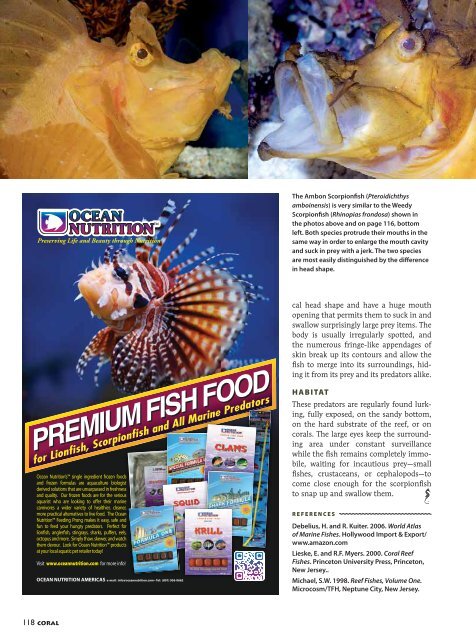You also want an ePaper? Increase the reach of your titles
YUMPU automatically turns print PDFs into web optimized ePapers that Google loves.
The Ambon Scorpionfish (Pteroidichthys<br />
amboinensis) is very similar to the Weedy<br />
Scorpionfish (Rhinopias frondosa) shown in<br />
the photos above and on page 116, bottom<br />
left. Both species protrude their mouths in the<br />
same way in order to enlarge the mouth cavity<br />
and suck in prey with a jerk. The two species<br />
are most easily distinguished by the difference<br />
in head shape.<br />
PREMIUM FISH FOOD<br />
for Lionfish, Scorpionfish and nd All Marine Predators<br />
Ocean Nutrition’s single ingredient frozen foods<br />
and frozen formulas are aquaculture biologist<br />
derived solutions that are unsurpassed in freshness<br />
and quality. Our frozen foods are for the serious<br />
aquarist who are looking to offer their marine<br />
carnivores a wider variety of healthier, cleaner,<br />
more practical alternatives to live food. The Ocean<br />
Nutrition Feeding Prong makes it easy, safe and<br />
fun to feed your hungry predators. Perfect for<br />
lionfish, anglerfish, stingrays, sharks, puffers, eels,<br />
octopus and more. Simply thaw, skewer, and watch<br />
them devour. Look for Ocean Nutrition products<br />
at your local aquatic pet retailer today!<br />
Visit www.oceannutrition.com for more info!<br />
OCEAN NUTRITION AMERICAS<br />
cal head shape and have a huge mouth<br />
opening that permits them to suck in and<br />
swallow surprisingly large prey items. The<br />
body is usually irregularly spotted, and<br />
the numerous fringe-like appendages of<br />
skin break up its contours and allow the<br />
fish to merge into its surroundings, hiding<br />
it from its prey and its predators alike.<br />
HABITAT<br />
These predators are regularly found lurking,<br />
fully exposed, on the sandy bottom,<br />
on the hard substrate of the reef, or on<br />
corals. The large eyes keep the surrounding<br />
area under constant surveillance<br />
while the fish remains completely immobile,<br />
waiting for incautious prey—small<br />
fishes, crustaceans, or cephalopods—to<br />
come close enough for the scorpionfish<br />
to snap up and swallow them.<br />
REFERENCES<br />
Debelius, H. and R. Kuiter. 2006. World Atlas<br />
of Marine Fishes. Hollywood Import & Export/<br />
www.amazon.com<br />
Lieske, E. and R.F. Myers. 2000. Coral Reef<br />
Fishes. Princeton University Press, Princeton,<br />
New Jersey..<br />
Michael, S.W. 1998. Reef Fishes, Volume One.<br />
Microcosm/TFH, Neptune City, New Jersey.<br />
118 CORAL

















